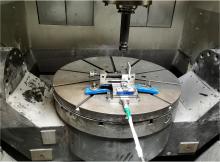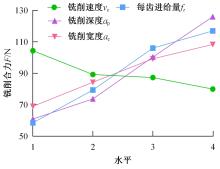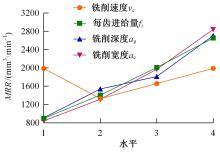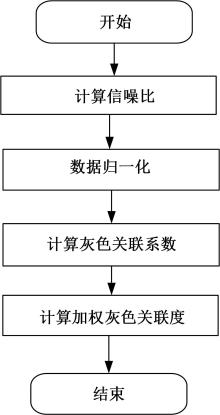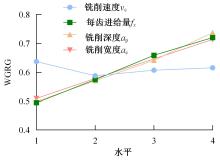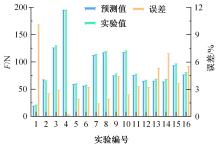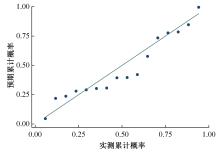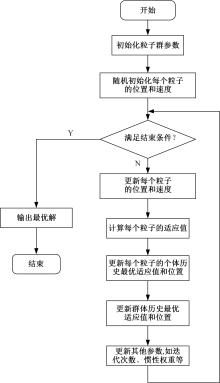Journal of Jilin University(Engineering and Technology Edition) ›› 2024, Vol. 54 ›› Issue (4): 917-925.doi: 10.13229/j.cnki.jdxbgxb.20220681
Previous Articles Next Articles
Milling analysis and parameter optimization for TC4 titanium alloy material
Ya-dong GONG( ),Ming-xiang DING,Xiang LI,Jin-min TIAN
),Ming-xiang DING,Xiang LI,Jin-min TIAN
- School of Mechanical Engineering and Automation,Northeastern University,Shenyang 110819
CLC Number:
- TH161
| 1 | Tan Liang, Yao Chang-feng, Ren Jun-xue, et al. Effect of cutter path orientations on cutting forces, tool wear, and surface integrity when ball end milling TC17[J]. The International Journal of Advanced Manufacturing Technology, 2017, 88(9-12): 2589-2602. |
| 2 | 张翔宇, 路正惠, 彭振龙, 等. 钛合金的高质高效超声振动切削加工[J]. 机械工程学报, 2021, 57(5): 133-147. |
| Zhang Xiang-yu, Lu Zheng-hui, Peng Zhen-long, et al. High quality and efficient ultrasonic vibration cutting of titanium alloys[J]. Journal of Mechanical Engineering, 2021, 57(5): 133-147. | |
| 3 | Li J, Yang X, Ren C, et al. Multiobjective optimization of cutting parameters in Ti-6Al-4V milling process using nondominated sorting genetic algorithm-II[J]. The International Journal of Advanced Manufacturing Technology, 2015, 76: 941-953. |
| 4 | Serra R, Chibane H, Duchosal A. Multi-objective optimization of cutting parameters for turning AISI 52100 hardened steel[J]. International Journal of Advanced Manufacturing Technology, 2018, 99(5-8): 2025-2034. |
| 5 | Zhu Li-da, Yang Zhi-chao, Li Zhao-bin. Investigation of mechanics and machinability of titanium alloy thin-walled parts by CBN grinding head[J]. The International Journal of Advanced Manufacturing Technology, 2019, 100(9-12): 2537-2555. |
| 6 | Wu D, Wang H, Zhang K, et al. Research on formation mechanism and optimization method of surface waviness of TC4 blisk blade[J]. Journal of Manufacturing Processes, 2019, 39: 305-326. |
| 7 | Shen X, Zhang D, Yao C, et al. Formation mechanism of surface metamorphic layer and influence rule on milling TC17 titanium alloy[J]. The International Journal of Advanced Manufacturing Technology, 2021, 112(7,8): 2259-2276. |
| 8 | Ngoc Chien Vu, Chour Huang Shyh, Huu That Nguyen. Multi-objective optimization of surface roughness and cutting forces in hard milling using taguchi and response surface methodology[J]. Key Engineering Materials, 2018, 773: 220-224. |
| 9 | Karkalos N E, Galanis N I, Markopoulos A P. Surface roughness prediction for the milling of Ti6Al4V ELI alloy with the use of statistical and soft computing techniques[J]. Measurement, 2016, 90: 25-35. |
| 10 | 易茜, 李聪波, 潘建, 等. 薄板类零件加工精度可靠性分析及工艺参数优化[J]. 中国机械工程, 2022, 33(11): 1269-1277. |
| Yi Qian, Li Cong-bo, Pan Jian,et al. Reliability analysis of machining accuracy and processing parameter optimization for thin-plate parts[J]. China Mechanical Engineering, 2022, 33(11): 1269-1277. | |
| 11 | Monir K O, Samy E A A. Optimization of cutting conditions using regression and genetic algorithm in end milling[J]. International Journal of Engineering Research in Africa, 2016, 20: 12-18. |
| 12 | Venkatesh M, Suresh K R N. Optimization of milling operations using artificial neural networks (ANN) and simulated annealing algorithm (SAA)[J]. Materials Today: Proceedings, 2018, 5(2): 4971-4985. |
| 13 | Djordje V, Katica S, Zeljko K, et al. Multi-objective optimization of steel AISI 1040 dry turning using genetic algorithm[J]. Neural Computing & Applications, 2021, 33(19): 12445-12475. |
| 14 | Eskandari B, Davoodi B, Ghorbani H. Multi-objective optimization of parameters in turning of N-155 iron-nickel-base superalloy using gray relational analysis[J]. Journal of the Brazilian Society of Mechanical Sciences and Engineering, 2018, 40(4): No.233. |
| 15 | Maiyar L M, Ramanujam R, Venkatesan K, et al. Optimization of machining parameters for end milling of inconel 718 super alloy using taguchi based grey relational analysis[J]. Procedia Engineering, 2013, 64: 1276-1282. |
| 16 | Ic Y T, Yildirim S. MOORA-based taguchi optimisation for improving product or process quality[J]. International Journal of Production Research, 2013, 51(11): 3321-3341. |
| 17 | 魏子茹, 卢延辉, 王鹏宇, 等. 基于CRITIC法的灰色关联理论在无人驾驶车辆测试评价中的应用[J]. 机械工程学报, 2021, 57(12): 99-108. |
| Wei Zi-ru, Lu Yan-hui, Wang Peng-yu, et al. Application of grey correlation theory based on CRITIC method in autonomous vehicles test and evaluation[J]. Journal of Mechanical Engineering, 2021, 57(12): 99-108. | |
| 18 | 曾念寅, 宋丹丹, 李寒, 等. 改进鲸鱼优化算法及涡轮盘结构优化[J]. 机械工程学报, 2021, 57(20): 254-265. |
| Zeng Nian-yin, Song Dan-dan, Li Han, et al. Improved whale optimization algorithm and turbine disk structure optimization[J]. Journal of Mechanical Engineering, 2021, 57(20): 254-265. | |
| 19 | 易茜, 柳淳, 李聪波, 等. 基于小样本数据驱动的滚齿工艺参数低碳优化决策方法[J]. 中国机械工程, 2022, 33(13): 1604-1612. |
| Yi Qian, Liu Chun, Li Cong-bo, et al. A low carbon optimization decision method for gear hobbing process parameters driven by small sample data[J]. China Mechanical Engineering, 2022, 33(13): 1604-1612. | |
| 20 | 卫星驰, 赵嫚, 杨青平, 等. 考虑工件变形的五轴侧铣薄壁件铣削力建模[J]. 机械工程学报, 2022, 58(7): 317-324. |
| Wei Xing-chi, Zhao Man, Yang Qing-ping, et al. Milling force modeling of thin-walled parts with 5-Axis flank milling considering workpiece deformation[J]. Journal of Mechanical Engineering, 2022, 58(7): 317-324. | |
| 21 | 于繁华, 刘仁云, 张义民, 等. 机械零部件动态可靠性稳健优化设计的群智能算法[J]. 吉林大学学报:工学版, 2017, 47(6): 1903-1908. |
| Yu Fan-hua, Liu Ren-yun, Zhang Yi-min, et al. Swarm intelligence algorithm of dynamic reliability-based robust optimization design of mechanic components[J]. Journal of Jilin University(Engineering and Technology Edition), 2017, 47(6): 1903-1908. | |
| 22 | 张禹, 鹿浩, 吕董, 等. 基于IMOFA的航空发动机管路多目标优化布局[J]. 东北大学学报:自然科学版, 2022, 43(8): 1120-1126. |
| Zhang Yu, Lu Hao, Dong Lyu, et al. Multi-objective optimization layout of aero-engine pipe routing based on IMOFA[J]. Journal of Northeastern University(Natural Science), 2022, 43(8): 1120-1126. | |
| 23 | 陈昭明,邹劲松,王伟,等. 改进粒子群神经网络融合有限元分析的铸锻双控动态成型多目标优化[J]. 吉林大学学报:工学版, 2022, 52(7): 1524-1533. |
| Chen Zhao-ming, Zou Jin-song, Wang Wei, et al. Multi-objective optimization of casting-forging dynamic forming based on improved particle swarm neural network and finite element analysis[J]. Journal of Jilin University(Engineering and Technology Edition), 2022, 52(7): 1524-1533. |
| [1] | Guo-jin TAN,Qing-wen KONG,Xin HE,Pan ZHANG,Run-chao YANG,Yang-jun CHAO,Zhong YANG. Bridge scour depth identification based on dynamic characteristics and improved particle swarm optimization algorithm [J]. Journal of Jilin University(Engineering and Technology Edition), 2023, 53(6): 1592-1600. |
| [2] | Jian WU,Bin XU. Displacement interval prediction model and simulation of accumulation landslide based on ceemdan theory [J]. Journal of Jilin University(Engineering and Technology Edition), 2023, 53(2): 562-568. |
| [3] | Jie LI,Chang-wang JIA,Qi ZHAO. Solution of nonlinear equilibrium state of vehicle steering and its stability determination [J]. Journal of Jilin University(Engineering and Technology Edition), 2023, 53(12): 3326-3334. |
| [4] | Zheng ZHANG,Qi-dan ZHU,Xiao-long LYU,Xing FAN. Optimized method for solving inverse kinematics of redundant manipulator [J]. Journal of Jilin University(Engineering and Technology Edition), 2023, 53(12): 3379-3387. |
| [5] | Pei-ran YING,Xiao-qing ZENG,Tuo SHEN,Teng-fei YUAN,Hai-feng SONG,Yi-zeng WANG. Redundant operation code-based intelligent algorithm for energy⁃efficient driving of high-speed train [J]. Journal of Jilin University(Engineering and Technology Edition), 2023, 53(12): 3404-3414. |
| [6] | Yong-gang CHEN,Ji-ye XU,Hai-yong WANG,Wen-xiang XIONG. Fault diagnosis method of point machine based on adaptive neural fuzzy inference network system [J]. Journal of Jilin University(Engineering and Technology Edition), 2023, 53(11): 3274-3280. |
| [7] | Zhi HUANG,Jie MIN,Tao ZHOU,Jian YANG,Li-xing XIAO,Lin-ze LI. Modeling and analysis of grinding force for grinding titanium alloy with abrasive belt assisted by ultrasonic vibration [J]. Journal of Jilin University(Engineering and Technology Edition), 2023, 53(11): 3069-3077. |
| [8] | Li HUI,Jia-chen LU,Song ZHOU,Jin-lan AN,Guan-yan ZHOU,Xiao-peng LIU. Effect of heat treatment on fatigue properties of TC4 titanium alloy by laser double beam welded joint [J]. Journal of Jilin University(Engineering and Technology Edition), 2023, 53(1): 105-110. |
| [9] | Jin-wu GAO,Zhi-huan JIA,Xiang-yang WANG,Hao XING. Degradation trend prediction of proton exchange membrane fuel cell based on PSO⁃LSTM [J]. Journal of Jilin University(Engineering and Technology Edition), 2022, 52(9): 2192-2202. |
| [10] | Chong ZHANG,Yun-feng HU,Xun GONG,Yao SUN. Design of model⁃free adaptive sliding mode controller for cathode flow of fuel cell [J]. Journal of Jilin University(Engineering and Technology Edition), 2022, 52(9): 2085-2095. |
| [11] | Ren-chu GUAN,Bao-run HE,Yan-chun LIANG,Xiao-hu SHI. Particle swarm optimization algorithm based on kinship selection [J]. Journal of Jilin University(Engineering and Technology Edition), 2022, 52(8): 1842-1849. |
| [12] | Jing QIN,De ZHENG,Yi-qiang PEI,Yong LYU,Qing-peng SU,Ying-bo WANG. Prediction method of engine performance and emission based on PSO-GPR [J]. Journal of Jilin University(Engineering and Technology Edition), 2022, 52(7): 1489-1498. |
| [13] | Zhen WANG,Meng GAI,Heng-shuo XU. Surface reconstruction algorithm of 3D scene image based on virtual reality technology [J]. Journal of Jilin University(Engineering and Technology Edition), 2022, 52(7): 1620-1625. |
| [14] | Hai-yan XING,Chao LIU,Cheng XU,Yu-huan CHEN,Song-hong-ze WANG. Quantitative metal magnetic memory classification model of weld grades based on particle swarm optimization fuzzy C⁃means [J]. Journal of Jilin University(Engineering and Technology Edition), 2022, 52(3): 525-532. |
| [15] | Wei LUO,Bo LU,Fei CHEN,Teng MA. Fault diagnosis method of NC turret based on PSO⁃SVM and time sequence [J]. Journal of Jilin University(Engineering and Technology Edition), 2022, 52(2): 392-399. |
|
||
